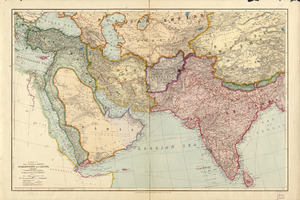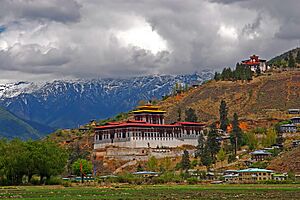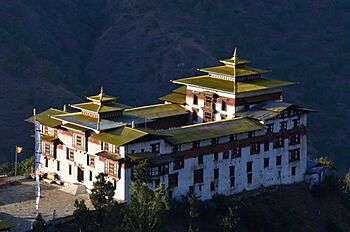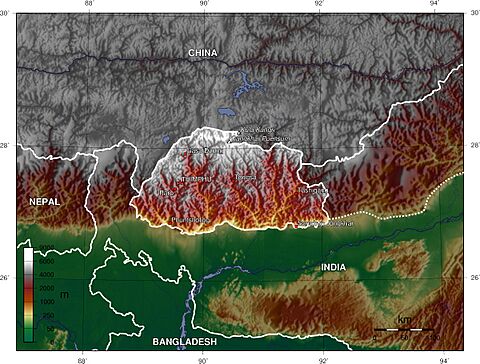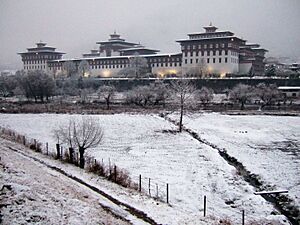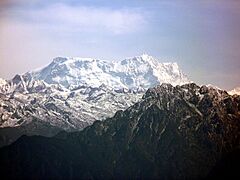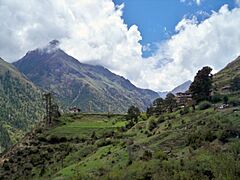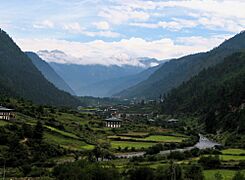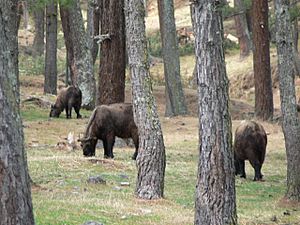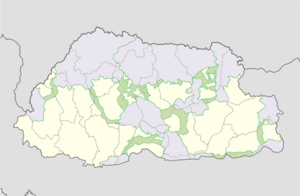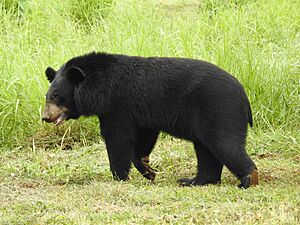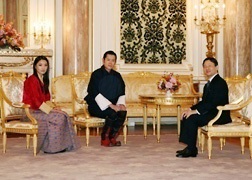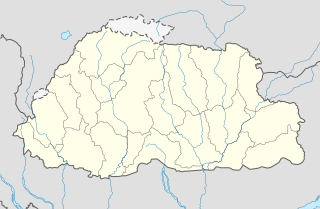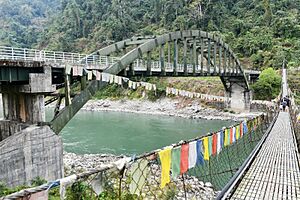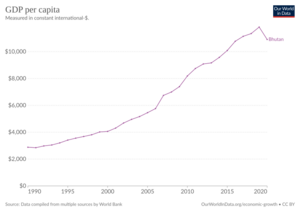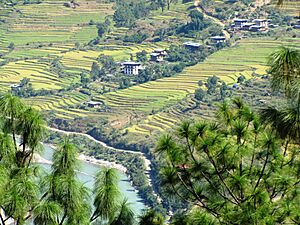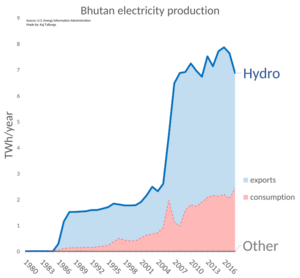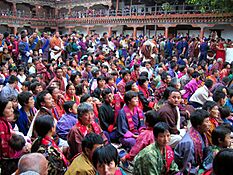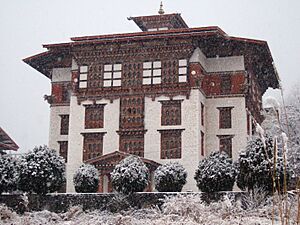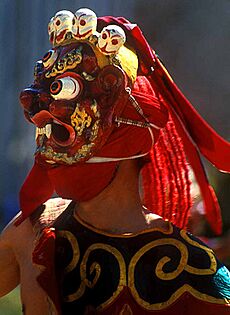Bhutan facts for kids
Quick facts for kids
Kingdom of Bhutan
|
|
|---|---|
|
Anthem: འབྲུག་ཙན་དན
Druk Tsenden "The Thunder Dragon Kingdom" |
|
 |
|
| Capital and largest city
|
Thimphu 27°28.0′N 89°38.5′E / 27.4667°N 89.6417°E |
| Official languages | Dzongkha |
| Religion
(2020)
|
|
| Demonym(s) | Bhutanese |
| Government | Unitary parliamentary semi-constitutional monarchy |
| Jigme Khesar Namgyel Wangchuck | |
| Tshering Tobgay | |
| Legislature | Parliament |
| National Council | |
| National Assembly | |
| Formation | |
|
• Unification of Bhutan
|
1616–1634 |
|
• Period of Desi administration
|
1650–1905 |
|
• Start of the Wangchuck dynasty
|
17 December 1907 |
| 8 August 1949 | |
| 21 September 1971 | |
|
• Constitutional monarchy
|
18 July 2008 |
| Area | |
|
• Total
|
38,394 km2 (14,824 sq mi) (133rd) |
|
• Water (%)
|
1.1 |
| Population | |
|
• 2018 estimate
|
754,388 (159th) |
|
• 2022 census
|
727,145 |
|
• Density
|
19.6/km2 (50.8/sq mi) (210th) |
| GDP (PPP) | 2023 estimate |
|
• Total
|
|
|
• Per capita
|
|
| GDP (nominal) | 2023 estimate |
|
• Total
|
|
|
• Per capita
|
|
| Gini (2022) | ▼ 28.5 low |
| HDI (2022) | medium · 125th |
| Currency | Ngultrum (BTN) |
| Time zone | UTC+06 (BTT) |
| Date format | YYYY-MM-DD |
| Driving side | left |
| Calling code | +975 |
| ISO 3166 code | BT |
| Internet TLD | .bt |
|
|
Bhutan, also known as the Kingdom of Bhutan, is a country in South Asia. It is a landlocked nation, meaning it has no coastline. Bhutan is nestled in the Eastern Himalayas, with China to its north and India to its south.
Bhutan has a population of over 727,145 people. Its land area is about 38,394 square kilometers (14,824 square miles). This makes it the 133rd largest country by land and 160th by population. Bhutan is a constitutional monarchy. This means it has a king, called the Druk Gyalpo, as the head of state. A prime minister leads the government. The Je Khenpo is the head of the country's official religion, Vajrayana Buddhism.
The northern part of Bhutan has tall Himalayan mountains. These mountains rise from green subtropical plains in the south. Some peaks in the Bhutanese Himalayas are over 7,000 meters (23,000 feet) high. Gangkhar Puensum is Bhutan's highest peak. It is also the highest unclimbed mountain in the world. Bhutan is famous for its diverse wildlife. This includes the Himalayan takin and golden langur. The capital and largest city is Thimphu. About 15% of Bhutan's population lives there.
Contents
Understanding the Name "Bhutan"
The exact meaning of "Bhutan" is not fully known. It might come from the Tibetan word "Böd," which means Tibet. People often think it comes from the Sanskrit words Bhoṭa-anta. This means "end of Tibet." It refers to Bhutan's location at the southern edge of the Tibetan plateau and its culture.
Bhutan's Journey Through Time
Evidence like stone tools and old structures shows people lived in Bhutan as early as 2000 BC. But we don't have written records from that time. Historians believe a state called Lhomon or Monyul might have existed between 500 BC and AD 600. These names mean "southern darkness" or "Dark Land." They refer to the Monpa, an ethnic group in Bhutan.
Buddhism first came to Bhutan in the 7th century AD. The Tibetan king Songtsen Gampo (who ruled from 627–649) was a Buddhist. He ordered two Buddhist temples to be built. These were in Bumthang in central Bhutan and Kyichu near Paro. Buddhism really grew in 746 AD under King Sindhu Rāja.
Much of Bhutan's early history is unclear. Many old records were lost in a fire in Punakha in 1827. By the 10th century, religion greatly shaped Bhutan's politics. Different Buddhist groups grew, supported by various Mongol leaders.
After the Yuan dynasty fell in the 14th century, these groups fought for power. This led to the rise of the Drukpa Lineage by the 16th century.
Before the early 17th century, Bhutan was made up of many small, warring areas. Then, a Tibetan lama and military leader named Ngawang Namgyal united the country. He had fled religious persecution in Tibet. To protect Bhutan from Tibetan attacks, Namgyal built strong fortresses called dzongs. He also created the Tsa Yig, a law code. This helped him bring local leaders under one central rule. Many of these dzongs still exist today. They are important centers for religion and local government.
The first Europeans to visit Bhutan were two Portuguese Jesuits, Estêvão Cacella and João Cabral, in 1627. They met Zhabdrung Ngawang Namgyal. They offered him weapons and help against Tibet, but he said no.
When Ngawang Namgyal died in 1651, his death was kept secret for 54 years. After a time of peace, Bhutan faced internal conflicts. In the 18th century, the Bhutanese took over the kingdom of Koch Bihar. In 1772, the ruler of Koch Bihar asked the British East India Company for help. The British helped remove the Bhutanese and then attacked Bhutan in 1774. A peace treaty was signed. Bhutan agreed to go back to its old borders. But fighting with the British continued for another hundred years.
This fighting led to the Duar War (1864–65). This war was about who would control the Bengal Duars. Bhutan lost the war. The Treaty of Sinchula was signed between British India and Bhutan. Bhutan gave up the Duars to the United Kingdom. In return, they received a payment of 50,000 Indian Rupees. This treaty ended all fighting between British India and Bhutan.
In the 1870s, civil war broke out in Bhutan. This was due to power struggles between the valleys of Paro and Tongsa. Eventually, Ugyen Wangchuck, the governor of Trongsa, rose to power. He defeated his enemies and united the country after several civil wars from 1882–85.
In 1907, Ugyen Wangchuck was chosen as the first hereditary king of Bhutan. The British government quickly recognized this new monarchy. In 1910, Bhutan signed the Treaty of Punakha. This treaty gave the British control over Bhutan's foreign affairs. After India became independent from the United Kingdom in 1947, Bhutan was one of the first countries to recognize India's independence. On August 8, 1949, a new treaty was signed with independent India. It was similar to the 1910 treaty.
In 1953, King Jigme Dorji Wangchuck created the country's legislature. This was a 130-member National Assembly. It aimed to make the government more democratic. In 1965, he set up a Royal Advisory Council. In 1968, he formed a Cabinet. In 1971, Bhutan joined the United Nations. In July 1972, Jigme Singye Wangchuck became king at age sixteen.
Bhutan's plan for 1987–92 included a policy called 'one nation, one people'. It introduced a code of traditional dress and manners called Driglam Namzhag. This code required all citizens to wear the gho (a knee-length robe for men) and the kira (an ankle-length dress for women). A key part of Bhutan's government policy since the late 1960s has been to modernize the use of the Dzongkha language. This started in 1964 by stopping the use of Hindi. As a result, in March 1990, the teaching of Nepali in schools was stopped. All Nepali school materials were removed.
Bhutan's Shift to Modern Government
Bhutan's political system has recently changed. It moved from a system where the king had all power to a constitutional monarchy. King Jigme Singye Wangchuck gave most of his power to the Council of Cabinet Ministers. He also allowed the National Assembly to remove the King from power with a two-thirds vote.
In 1999, the government allowed television and the internet. Bhutan was one of the last countries to get TV. The King said TV was important for Bhutan's modernization. He also said it would help with the country's gross national happiness. But he warned that misusing this new technology could harm traditional Bhutanese values.
A new constitution was introduced in 2005. In December 2005, King Wangchuck announced he would give up his throne to his son in 2008. On December 9, 2006, he decided to step down immediately. This led to the first national parliamentary elections in December 2007 and March 2008.
On November 6, 2008, Jigme Khesar Namgyel Wangchuck, then 28, became king.
In July 2021, during the COVID-19 pandemic, Bhutan became a world leader in vaccination. It vaccinated 470,000 out of 770,000 people with two doses of AstraZeneca vaccines.
On December 13, 2023, Bhutan was officially removed from the list of least developed countries. This means its economy has grown stronger.
Bhutan's Geography and Nature
Bhutan is located on the southern slopes of the eastern Himalayas. It is a landlocked country. To the north is the Tibet Autonomous Region of China. To the west and south are the Indian states of Sikkim, West Bengal, and Assam. To the east is the Indian state of Arunachal Pradesh. The land is mostly made of steep, high mountains. Swift rivers crisscross these mountains. They form deep valleys before flowing into the Indian plains. In fact, 98.8% of Bhutan is covered by mountains. This makes it the most mountainous country in the world.
The elevation in Bhutan ranges greatly. It goes from 200 meters (660 feet) in the southern foothills. It rises to over 7,000 meters (23,000 feet) in the north. This huge difference in landscape and climate gives Bhutan amazing biodiversity.
Bhutan's northern area has Eastern Himalayan alpine shrub and meadows. These reach up to icy mountain peaks. The climate there is extremely cold. Most northern peaks are over 7,000 meters (23,000 feet) above sea level. Gangkhar Puensum is Bhutan's highest point at 7,570 meters (24,840 feet). It is known as the highest unclimbed mountain in the world. Snow-fed rivers water the alpine valleys in this region. These valleys provide grazing land for animals. A small number of traveling shepherds live here.
The Black Mountains are in central Bhutan. They divide two main river systems: the Mo Chhu and the Drangme Chhu. Peaks in the Black Mountains are between 1,500 and 4,925 meters (4,921 and 16,158 feet) high. Fast-flowing rivers have carved deep gorges in the lower mountain areas. The forests here have Eastern Himalayan subalpine conifer forests at higher elevations. Lower down, there are Eastern Himalayan broadleaf forests. These central forests provide most of Bhutan's wood. The Torsa, Raidāk, Sankosh, and Manas are Bhutan's main rivers. Most of the population lives in these central highlands.
In the south, the Sivalik Hills are covered with thick Himalayan subtropical broadleaf forests. There are also flat river valleys and mountains up to about 1,500 meters (4,900 feet) high. The foothills lead down to the subtropical Duars Plain. This plain is a natural gateway to important mountain passes. Most of the Duars is in India. But a 10 to 15 km (6 to 9 mi) wide strip extends into Bhutan. The northern Duars in Bhutan have rough, sloped land and dry soil. They have thick plants and lots of wildlife. The southern Duars have fertile soil, tall grass, thick jungle, and fresh springs. Mountain rivers, fed by melting snow or monsoon rains, flow into the Brahmaputra River in India. In October 2005, 64% of Bhutan was covered by forests.
- Landscape of Bhutan
-
Gangkar Puensum, the highest mountain in Bhutan
-
The Haa Valley in Western Bhutan
Bhutan's Climate Zones
Bhutan's climate changes with how high up you are. It's subtropical in the south. It's temperate in the highlands. And it's polar-type with snow all year in the north. Bhutan has five different seasons: summer, monsoon, autumn, winter, and spring. Western Bhutan gets heavier monsoon rains. Southern Bhutan has hot, humid summers and cool winters. Central and eastern Bhutan are temperate and drier. They have warm summers and cool winters.
Amazing Animals and Plants
Bhutan has many kinds of primates. These include rare species like the golden langur. A special kind of Assamese macaque has also been seen. Some experts think it's a new species.
In the tropical lowland forests in the south, you can find Bengal tigers, clouded leopards, hispid hares, and sloth bears. In the temperate zone, grey langurs, tigers, gorals, and serows live in mixed forests. Fruit trees and bamboo provide homes for Himalayan black bears, red pandas, squirrels, sambar deer, wild pigs, and barking deer. The high Himalayan areas in the north are home to snow leopards, blue sheep, Himalayan marmots, Tibetan wolfs, antelopes, Himalayan musk deer, and the Bhutan takin. The takin is Bhutan's national animal. The endangered wild water buffalo also lives in southern Bhutan, but in small numbers.
More than 770 types of birds have been seen in Bhutan. The globally endangered white-winged duck was added to Bhutan's bird list in 2006.
A 2010 BBC show called Lost Land of the Tiger explored Bhutan. It showed the first video of tigers living at 4,000 meters (13,000 feet) in the high Himalayas. The video showed a female tiger and later a male tiger. This suggests they might be breeding at this high elevation. Cameras also recorded other rare forest animals. These included dholes (wild dogs), Asian elephants, leopards, and leopard cats.
Bhutan's Rich Plant Life
About 71% of Bhutan's land is covered by forests. This was about 2,725,080 hectares (ha) in 2020. This is an increase from 2,506,720 ha in 1990. In 2020, natural forests covered 2,704,260 ha. Planted forests covered 20,820 ha. About 15% of the natural forest was primary forest. This means it had native trees with no clear signs of human activity. About 41% of the forest area was in protected zones. In 2015, all forest land was owned by the government.
More than 5,400 types of plants grow in Bhutan. This includes Pedicularis cacuminidenta. Fungi are very important in Bhutan's ecosystems. Some fungi help forest trees get nutrients. Other fungi help break down wood and leaves, which is important for natural recycling.
Protecting Nature in Bhutan
The Eastern Himalayas is a global hotspot for biodiversity. It is one of the 234 most important ecoregions in the world. This was found in a study by WWF.
Bhutan is seen as a great example for protecting nature. It has earned international praise for its efforts. The country has decided to keep at least 60% of its land covered by forests. More than 40% of its land is national parks and protected areas. Recently, another 9% of land was set aside as corridors. These corridors connect the protected areas. This allows animals to move freely across the country. Protecting the environment is central to Bhutan's development plan. It is not just one part of the plan. It is a main idea that guides all development. The country's constitution also includes rules about protecting the environment.
Environmental Challenges
Bhutan's nature is mostly untouched. But the government knows it needs to keep working to protect it. Environmental protection is a challenge for the future. Almost 56.3% of all Bhutanese people work in farming, forestry, or conservation. The government wants to promote conservation as part of its goal for Gross National Happiness. Bhutan actually has negative greenhouse gas emissions. This means its forests absorb more pollution than the country creates. Bhutan produces about 2.2 million tons of carbon dioxide a year. But its huge forests, covering 72% of the country, absorb over 4 million tons of carbon dioxide every year. In 2018, Bhutan ranked 16th globally for forest health.
Bhutan has good environmental policies. The head of the UNFCCC called Bhutan an "inspiration and role model." For example, electric cars are encouraged. As of 2014, they made up one-tenth of all cars. Bhutan gets most of its energy from hydroelectric power. This means it doesn't create much greenhouse gas for energy.
Sometimes, protected wildlife enters farming areas. This can damage crops and kill farm animals. To help, Bhutan has started an insurance plan. They are building solar-powered fences and watch towers. They also provide food and salt for animals outside human areas. This encourages animals to stay away.
The high value of the Ophiocordyceps sinensis fungus has led to too much collection. This is hard to control.
Bhutan banned plastic bags from April 1, 2019. They were replaced with bags made from jute and other natural materials.
Government and How Bhutan is Run
Bhutan is a constitutional monarchy. This means it has a king and a parliamentary government. The Druk Gyalpo (Dragon King) is the head of state. All citizens can vote. The government has a National Council. This is an upper house with 25 elected members. It also has a National Assembly with 47 elected lawmakers from political parties.
The Council of Ministers, led by the Prime Minister, holds executive power. This means they carry out the laws. Both the government and the National Assembly have legislative power. This means they make the laws. The courts have judicial power, meaning they interpret the laws. The legal system is based on the old Tsa Yig code. It was also influenced by English common law in the 20th century. The chief justice leads the courts.
Bhutan's Local Divisions
Bhutan is divided into twenty Dzongkhag (districts). These are managed by a group called the Dzongkhag Tshogdu. In some thromdes (cities), a city government works directly under the Dzongkhag. In most areas, rural gewog (village blocks) are managed by groups called the Gewog Tshogde.
Cities elect leaders called Thrompons. They represent the city in the Dzongkhag Tshogdu. Villages elect headmen called gups and vice-headmen called mangmis. These also sit on the Dzongkhag Tshogdu. The smallest voting areas in Bhutan are called chiwogs.
| Dzongkhags of the Kingdom of Bhutan | |||
|---|---|---|---|
| District | Dzongkha name | District | Dzongkha name |
| 1. Bumthang | བུམ་ཐང་རྫོང་ཁག་ | 11. Samdrup Jongkhar | བསམ་གྲུབ་ལྗོངས་མཁར་རྫོང་ཁག་ |
| 2. Chukha | ཆུ་ཁ་རྫོང་ཁག་ | 12. Samtse | བསམ་རྩེ་རྫོང་ཁག་ |
| 3. Dagana | དར་དཀར་ན་རྫོང་ཁག་ | 13. Sarpang | གསར་སྤང་རྫོང་ཁག་ |
| 4. Gasa | མགར་ས་རྫོང་ཁག་ | 14. Thimphu | ཐིམ་ཕུ་རྫོང་ཁག་ |
| 5. Haa | ཧཱ་རྫོང་ཁག་ | 15. Trashigang | བཀྲ་ཤིས་སྒང་རྫོང་ཁག་ |
| 6. Lhuntse | ལྷུན་རྩེ་རྫོང་ཁག་ | 16. Trashiyangtse | བཀྲ་ཤིས་གཡང་རྩེ་རྫོང་ཁག་ |
| 7. Mongar | མོང་སྒར་རྫོང་ཁག་ | 17. Trongsa | ཀྲོང་གསར་རྫོང་ཁག་ |
| 8. Paro | སྤ་རོ་རྫོང་ཁག་ | 18. Tsirang | རྩི་རང་རྫོང་ཁག་ |
| 9. Pemagatshel | པད་མ་དགའ་ཚལ་རྫོང་ཁག་ | 19. Wangdue Phodrang | དབང་འདུས་ཕོ་བྲང་རྫོང་ཁག་ |
| 10. Punakha | སྤུ་ན་ཁ་རྫོང་ཁག་ | 20. Zhemgang | གཞམས་སྒང་རྫོང་ཁག་ |
Bhutan's Economy and Resources
Bhutan's money is called the ngultrum. Its value is linked to the Indian rupee. The Indian rupee is also used as money in Bhutan.
Bhutan's economy is one of the smallest in the world. But it has grown very fast recently. In 2007, Bhutan had the second-fastest-growing economy in the world. This was mainly because of the huge Tala Hydroelectric Power Station. As of 2012, each person's income was about US$2,420.
Bhutan's economy relies on farming, forests, tourism, and selling hydroelectric power to India. Farming is the main way 55.4% of people make a living. Most farming is for families to grow their own food. Handicrafts, like weaving and making religious art, are small home businesses. Building roads and other things is hard and costly. This is because the land is very mountainous.
Bhutan has no railways. But India plans to connect southern Bhutan to its railway network. This agreement was signed in 2005. Bhutan and India signed a 'free trade' agreement in 2008. This allowed Bhutanese goods to pass through India without extra taxes. Bhutan used to trade with the Tibet Autonomous Region of China. But it closed its border with China in 1960.
Bhutan has more natural resources than it uses. In 2016, Bhutan had 5.0 global hectares of resources per person. The world average was 1.6. Bhutan used 4.5 global hectares per person. This means Bhutan has a reserve of natural resources.
The industrial sector is still new. Most goods come from small home businesses. But larger industries are being encouraged. Some industries like cement and steel have been set up. Many building projects, like roads, use workers from India. Farm products include rice, chilies, dairy products (from yaks and cows), buckwheat, barley, and fruits. Industries include cement, wood products, and drinks.
Bhutan's technology sector has grown recently. This includes green tech and online shopping. In May 2012, "Thimphu TechPark" opened. It helps new tech companies.
Incomes over Nu 100,000 per year are taxed. But few people earn this much. Bhutan's inflation rate was about 3% in 2003. Bhutan's total economic output (GDP) is about US$5.855 billion. This makes it the 158th largest economy. The income per person is about $7,641. Government income is $407.1 million. But spending is $614 million. India's Ministry of External Affairs pays for 25% of the budget.
Bhutan's exports include electricity, spices, wood, and handicrafts. They totaled €128 million in 2000. Imports were €164 million, leading to a trade deficit. Main imports are fuel, grain, and vehicles. India is Bhutan's main export partner, taking 58.6% of its goods. Hong Kong (30.1%) and Bangladesh (7.3%) are also top partners. Trade with China is almost non-existent. Bhutan's import partners include India (74.5%), Japan (7.4%), and Sweden (3.2%).
Farming in Bhutan
Farming's share in Bhutan's economy went down. It was about 55% in 1985 and 33% in 2003. In 2013, the government wanted Bhutan to be the first country with 100% organic farming. But ten years later, only 1% of farmland is organic.
Bhutanese red rice is Bhutan's most famous farm export. It is sold in North America and Europe. Bangladesh buys most of Bhutanese apples and oranges.
Fishing in Bhutan mainly focuses on trout and carp.
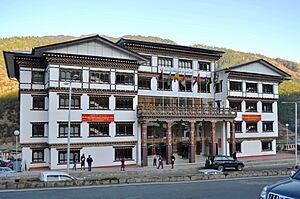
Bhutan's Industries
The industrial sector makes up 22% of the economy. Key industries include making ferroalloy, cement, metal poles, and steel. They also produce processed graphite, copper conductors, drinks, processed fruits, carpets, and wood products. The production of ferrosilicon was started by Damchae Dem.
Mining for Minerals
Bhutan has many mineral deposits. It commercially produces coal, dolomite, gypsum, and limestone. The country also has proven amounts of beryl, copper, graphite, lead, mica, pyrite, tin, tungsten, and zinc. However, Bhutan prefers to protect its environment. So, most of these minerals are not yet dug up.
Energy from Water
Bhutan's biggest export is hydroelectricity. As of 2015, it makes about 2,000 MW of hydropower. This comes from dams in Himalayan river valleys. The country could make 30,000 MW of hydropower. Power is sent to different states in India. New projects are planned with Bangladesh. Hydropower has been a main focus for Bhutan's development plans. As of 2015, the Tala Hydroelectric Power Station is its largest power plant. It has a capacity of 1,020 MW. Bhutan has received help from India, Austria, and the Asian Development Bank to build hydroelectric projects.
Besides hydropower, Bhutan has other renewable energy sources. These include solar, wind, and bioenergy. It could generate about 12,000 MW of solar energy. It could also generate about 760 MW of wind energy. Over 70% of its land is covered by forests. This is a huge source of bioenergy.
Money and Banks
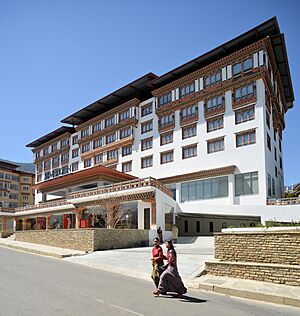
Bhutan has five commercial banks. The two largest are the Bank of Bhutan and the Bhutan National Bank. Both are in Thimphu. Other banks are Bhutan Development Bank, T-Bank, and Druk Punjab National Bank. The financial sector also has other non-banking institutions. These include the Royal Insurance Corporation of Bhutan (RICB). The central bank is the Royal Monetary Authority of Bhutan (RMA). The Royal Securities Exchange of Bhutan is the main stock exchange.
The SAARC Development Fund is located in Thimphu.
Tourism in Bhutan
In 2014, Bhutan welcomed 133,480 foreign visitors. Bhutan is a high-value travel spot. It charges a daily fee of US$100 for most visitors. This fee helps with sustainable development. Citizens of India, Maldives, and Bangladesh do not pay this fee. Indians can get a permit for 1,200 INR per day (about US$14 in 2024). Tourism employs 21,000 people. It makes up 1.8% of the country's economy.
Bhutan does not have any UNESCO World Heritage Sites yet. But it has eight places being considered since 2012. These include old ruins, wildlife sanctuaries, and important dzongs. Bhutan also has many other tourist sites not on this list. Bhutan has one item on the UNESCO Intangible Cultural Heritage List. It is the Mask dance of the drums from Drametse.
Getting Around Bhutan
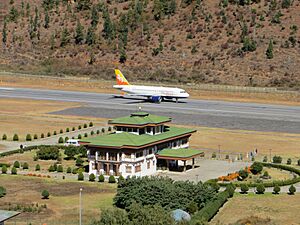
Air Travel
Paro Airport is Bhutan's only international airport. The national airline, Drukair, flies between Paro Airport and other airports. These include Bathpalathang Airport in Jakar (central Bhutan). Also, Gelephu Airport in Gelephu (south) and Yongphulla Airport in the east. Flights happen weekly.
Road Travel
The Lateral Road is Bhutan's main east-west road. It connects Phuentsholing in the southwest to Trashigang in the east. Important towns on this road are Wangdue Phodrang and Trongsa. The Lateral Road also has smaller roads connecting to Thimphu and other cities. Like other roads in Bhutan, the Lateral Road can be dangerous. This is due to road conditions, steep drops, sharp turns, weather, and landslides.
Since 2014, widening roads has been a top goal. Especially for the highway from Trashigang to Dochula. This project should finish by the end of 2017. It will make travel across the country much faster. It is also hoped that better roads will bring more tourists to eastern Bhutan. Currently, road conditions sometimes stop tourists from visiting. This is due to road blocks, landslides, and dust from the widening work.
Rail Connections
Bhutan does not have railways yet. But it agreed with India to connect southern Bhutan to India's railway network. This will be an 18 km (11 mi) long rail link. It will go between Hasimara in West Bengal and Gelephu in Bhutan. India will pay for building this railway. Bhutan's closest railway station is Hasimara. The planned Gelephu Green city will also be linked by railway.
People and Culture of Bhutan
Bhutan had a population of 754,388 people in 2018. The average age in Bhutan is 24.8 years. There are 1,070 males for every 1,000 females. About 66% of people in Bhutan can read and write.
Bhutan's Ethnic Groups
Bhutanese people mainly consist of the Ngalops and Sharchops. They are called Western Bhutanese and Eastern Bhutanese. The Sharchops are a bit larger in number. But the Ngalops are more powerful in politics. The King and political leaders belong to this group. Ngalops mostly live in western Bhutan. Their culture is very similar to Tibet's. The Sharchops are the largest group. They usually follow the Nyingmapa form of Tibetan Buddhism. This is different from the official Drukpa Kagyu form. Nowadays, with better transport, there is more marriage between these groups.
The Lhotshampa are "southerner Bhutanese." They are a mixed group, mostly of Nepalese background. They have sought more political and cultural recognition. This includes equal rights to live, use their language, and wear their traditional dress. In the 1980s, Bhutan started a policy called "One Nation One People." This aimed to strengthen the culture (language, dress, religion) and political power of the majority Drukpa people. As part of this, teaching Nepali in schools was stopped. Nepali school materials were also removed.
Major Cities and Towns
- Thimphu, the capital and largest city.
- Damphu, the main town of Tsirang District.
- Jakar, the main town of Bumthang District. Buddhism first came to Bhutan here.
- Mongar, the main business center in eastern Bhutan.
- Paro, where the international airport is located.
- Phuentsholing, Bhutan's main business hub.
- Punakha, the old capital city.
- Samdrup Jongkhar, a town in the southeast on the border with India.
- Trashigang, the main town of Trashigang District. This is the most populated district.
- Trongsa, in central Bhutan. It has the largest and most beautiful of all the dzongs in Bhutan.
|
Largest cities or towns in Bhutan
According to the 2017 Census |
||
|---|---|---|
| Rank | Name | Pop. |
| 1 | Thimphu | 114,551 |
| 2 | Phuntsholing | 27,658 |
| 3 | Paro | 11,448 |
| 4 | Gelephu | 9,858 |
| 5 | Samdrup Jongkhar | 9,325 |
| 6 | Wangdue Phodrang | 8,954 |
| 7 | Punakha | 6,626 |
| 8 | Jakar | 6,243 |
| 9 | Nganglam | 5,418 |
| 10 | Samtse | 5,396 |
Religion in Bhutan
Religion in Bhutan (PewResearch) 2020 Buddhism (74.7%) Hinduism (22.6%) Bon (1.9%) Christianity (0.5%) Others (0.3%)
About two-thirds to three-quarters of Bhutan's people follow Vajrayana Buddhism. This is also the official religion. Hinduism makes up less than 12% of the population. Bhutan's laws allow freedom of religion. However, trying to convert people to a new religion is not allowed.
Buddhism came to Bhutan in 746 AD. This was when Guru Padmasambhava visited Bumthang District. Tibetan king Songtsän Gampo (who ruled from 627–649) was a Buddhist. He ordered two Buddhist temples to be built. One was in Bumthang and the other near Paro.
Languages Spoken in Bhutan
The national language is Dzongkha. It is one of 53 languages in the Tibetan language family. The writing system, called Chhokey, is the same as classical Tibetan. In Bhutan's schools, English is used for teaching. Dzongkha is taught as the national language. Ethnologue lists 24 languages spoken in Bhutan. Most are from the Tibeto-Burman family. Nepali is an Indo-Aryan language.
Before the 1980s, the government supported teaching Nepali in southern Bhutanese schools. But with the Driglam Namzhag (Bhutanese code of etiquette), Dzongkha's role was strengthened. Nepali was then removed from the school curriculum. The languages of Bhutan are still not fully understood. Some have not been deeply studied. Before the 1980s, the Lhotshampa (Nepali-speaking community) made up about 30% of the population. This was mainly in southern Bhutan.
Dzongkha is partly similar to Sikkimese. About 25% of the population speaks it as their first language. Tshangla is spoken by more people. It is the language of the Sharchop people. It is not easily grouped with other languages. It might be its own branch of Tibeto-Burman. Nepali speakers made up about 40% of the population in 2006. Larger minority languages include Dzala (11%), Limbu (10%), Kheng (8%), and Rai (8%).
Health and Education
Bhutan has a life expectancy of 70.2 years (2016 data). Basic healthcare in Bhutan is free. This is stated in the Constitution of Bhutan.
Historically, education in Bhutan was mainly in monasteries. Modern school education for everyone started in the 1960s. The mountainous land makes it hard to have integrated education services.
Today, Bhutan has two decentralized universities. They have eleven colleges across the country. These are the Royal University of Bhutan and the Khesar Gyalpo University of Medical Sciences of Bhutan. The first five-year plan (1961) set up a central education authority. It also created an organized, modern school system. This system offered free and universal primary education.
Education programs got a boost in 1990. The Asian Development Bank gave a US$7.13 million loan. This was for staff training, equipment, and building schools.
Since modern education began, teachers from India have worked in Bhutan. Many came from Kerala. In 2018, 43 retired teachers were invited to Thimphu. The King thanked them for their long service. In 2019, Bhutan's Education Minister honored 80 retired teachers in Kolkata, India. This celebrated 50 years of friendship between Bhutan and India. Currently, 121 teachers from India work in Bhutanese schools.
Bhutanese Culture and Traditions
Bhutan has a rich and special culture. It has stayed mostly the same because the country was isolated until the mid-20th century. One main reason tourists visit is to experience Bhutan's culture and traditions. Bhutanese traditions are deeply connected to its Buddhist heritage. Hinduism is the second largest religion. It is most common in the southern areas. The government is working hard to keep the country's culture and traditions alive. Because of its untouched nature and culture, Bhutan is sometimes called The Last Shangri-La.
Bhutanese citizens can travel abroad. But many foreigners see Bhutan as hard to visit. Another reason is the cost. It is expensive for tourists on a tight budget. People from India, Bangladesh, and the Maldives can enter for free. But other foreigners must book with a Bhutanese tour company. They pay about US$250 per day. This fee covers most travel, lodging, and meals. In 2011, Bhutan had 37,482 foreign visitors.
Bhutan was the first country in the world to ban tobacco. It was illegal to smoke in public or sell tobacco. This was under the Tobacco Control Act of Bhutan 2010. Violators were fined about $232. This was a month's salary in Bhutan. In 2021, this law changed. The new Tobacco Control Act 2021 allows tobacco products to be imported and sold. This was to stop smuggling during the pandemic.
Traditional Dress
The national dress for Bhutanese men is the gho. It is a knee-length robe tied at the waist with a cloth belt called the kera. Women wear an ankle-length dress, the kira. It is fastened at the shoulders with two brooches called koma. It is tied at the waist with a kera. Women also wear a long-sleeved blouse, the "wonju", under the kira. A jacket-like garment called the "toego" is worn over the kira. The sleeves of the wonju and tego are folded at the cuffs. The type of fabric, colors, and decorations show a person's social status.
Jewelry is often worn by women. Especially during religious festivals ("tsechus") and public gatherings. To strengthen Bhutan's identity, a law requires government employees to wear the national dress at work. All citizens must wear it when visiting schools and government offices. Many adults choose to wear it as formal attire.
Colorful scarves, called rachu for women and kabney for men, show social standing. Red is a common color for women. The "Bura Maap" (Red Scarf) is a high honor for a Bhutanese civilian. It, along with the title of Dasho, comes from the King. It recognizes great service to the nation.
Bhutanese Buildings
Bhutanese architecture is very traditional. It uses rammed earth and wattle and daub building methods. It also uses stone and detailed woodwork around windows and roofs. Traditional buildings do not use nails or iron bars. A special type of castle fortress is common in the region. It is called a dzong. Since ancient times, dzongs have been centers for religion and government in their districts. The University of Texas at El Paso in the United States has used Bhutanese architecture for its campus buildings. Other buildings in El Paso have also adopted this style.
Public Holidays
Bhutan has many public holidays. Most of these are traditional, seasonal, or religious festivals. They include the winter solstice (around January 1), Lunar New Year (February or March), the King's birthday, and the end of the monsoon season (September 22). National Day is on December 17. There are also various Buddhist and Hindu celebrations.
Music and Dance
Dance dramas and masked dances like the Cham dance are common at festivals. They are usually performed with traditional music. Dancers wear colorful wooden masks and special costumes. They show heroes, demons, spirits, animals, gods, and funny characters. Dancers are supported by the royal family. They help keep old folk and religious customs alive. They also preserve the art of mask-making.
Bhutanese music has traditional and modern types. Traditional music includes religious and folk songs. Modern rigsar music uses traditional instruments and electronic keyboards. It started in the early 1990s. It shows the influence of Indian popular music.
Family Life
In Bhutanese families, property usually passes through the female line. Daughters inherit their parents' house. A man is expected to make his own way. He often moves to his wife's home. Love marriages are more common in cities. But arranged marriages are still common in most rural areas. Although rare, polygamy (having more than one spouse) is accepted. It is often used to keep property within a family. The previous king, Jigme Singye Wangchuck, had four queens, all sisters. The current king, Jigme Khesar Namgyel Wangchuck, married Jetsun Pema, a commoner, on October 13, 2011.
Bhutanese Food
Rice (red rice), buckwheat, and increasingly maize, are the main foods in Bhutanese cuisine. People also eat pork, beef, yak meat, chicken, and lamb. Soups and stews are made with meat and dried vegetables. They are spiced with chilies and cheese. Ema datshi, made very spicy with cheese and chilies, is like the national dish. It is very common, and Bhutanese people are proud of it. Dairy foods are also popular. Especially butter and cheese from yaks and cows. Almost all milk is made into butter and cheese. Popular drinks include butter tea, black tea, local ara (rice wine), and beer.
Sports and Games

Bhutan's national and most popular sport is archery. Competitions happen regularly in most villages. It is different from Olympic archery. Two targets are placed over 100 meters (330 feet) apart. Teams shoot from one end of the field to the other. Each team member shoots two arrows per round. Traditional Bhutanese archery is a social event. Competitions are held between villages, towns, and amateur teams. There is usually lots of food and drink, with singing and dancing. People try to distract opponents by standing near the target and making fun of the shooter. Darts (khuru) is another popular outdoor team sport. Players throw heavy wooden darts with a 10 cm (4 in) nail at a target 10 to 20 meters (33 to 66 feet) away.
Another traditional sport is the Digor. It is similar to the shot put and horseshoe throwing.
Football is also popular. In 2002, Bhutan's national football team played Montserrat. This was called The Other Final. It happened on the same day Brazil played Germany in the World Cup final. At that time, Bhutan and Montserrat were the two lowest-ranked teams in the world. The match was in Thimphu's Changlimithang National Stadium. Bhutan won 4–0. A documentary was made about the match. In 2015, Bhutan won its first two FIFA World Cup Qualifying matches. They beat Sri Lanka 1–0 in Sri Lanka and 2–1 in Bhutan. Cricket has also become popular in Bhutan. Especially since Indian TV channels became available. The Bhutan national cricket team is one of the most successful teams in the region.
Images for kids
-
A thrikhep (throne cover) from the 19th century. Throne covers were placed atop the temple cushions used by high lamas. The central circular swirling symbol is the gankyil in its mode as the "Four Joys".
See also
 In Spanish: Bután para niños
In Spanish: Bután para niños




